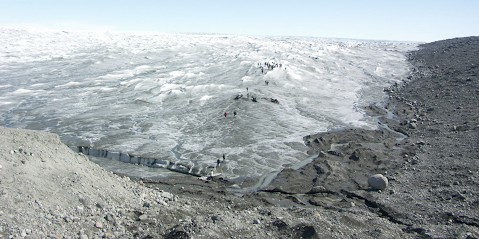1. Although push moraines are known here and there around the edges of modern glaciers, and around the edges of some areas glaciated in the Wolstonian or Devensian glacial episodes, quite unusual conditions are required. At the snout of the Thompson Glacier on Axel Heiberg Island, for example, the glacier front has been blocked for many years, causing the ice as it moves forward to shear into more or less parallel slices. These are called shear planes, and debris from the glacier bed is carried up along them to give rise to a very unusual and somewhat chaotic glacier front landscape. I have been there, and it's very spectacular. But generally ice does not move forward in a solid mass, fronted by a steep and bulldozing front edge, but by internal deformation, with sliding on the bed where melting is occurring and with the bed stuck to the bottom is the glacier is cold-based. Rock debris is sometimes dragged along on the bed, but it is more often lifted off the bottom and moved by internal deformation and sliding on shear planes. The internal dynamics are very complex. Generally much more material is dumped on the bed, or let down from the interior of the glacier during ice wastage, than is transported to the snout.
2. Terminal or marginal moraines are very spectacular, especially in association with very active glaciers, but if you look at the current edges of ice sheets in Greenland and Antarctica, big edge moraines are conspicuous by their absence. There are lots of small ones, associated with short-lived edge positions. Ice edges are in general not very static -- they may advance or retreat for short periods during either a period of overall growth or overall decay. I suspect that even at the peak of a glacial episode, an ice edge may be located at its most advanced position for just a few years. If it should be static for centuries or millennia, then big terminal moraines may be created, but again rather peculiar circumstances would be required for this to happen.
If you look at time-lapse photography of valley glaciers in the alps or Himalayas the "conveyor belt" analogy is a good one. Debris is transported up to the glacier surface below the equilibrium line, and then carried forwards, and it is supplemented by debris falling onto the ice surface from the valley sides. But there is no "bulldozing" as we would understand that word.
So the messages are these: ice in general does not bulldoze large ridges of moraine in its most advanced ice edge positions, and under optimal conditions a glacier dumps material under and within the ice body rather than at its snout.
Here is another pic of the edge of the ice sheet in West Greenland. Here we can see edge moraines quite clearly. They have to represent a "stage" (age unknown) from which the ice edge has retreated.
Oblique aerial photo of the ice sheet edge ion West Greenland -- here there are several morainic ridges, marking several stillstands.








No comments:
Post a Comment